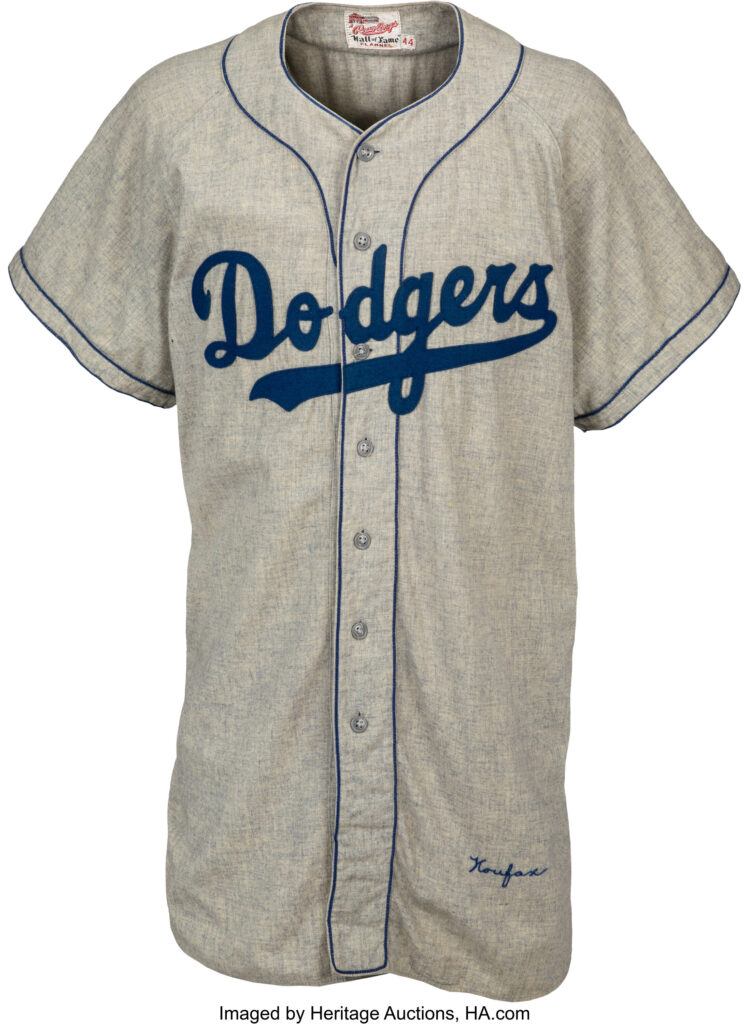Countless offerings among the almost 3,200 available in Heritage’s May 16-18 Spring Sports Catalog Auction could serve as its centerpiece, its highlight — that one thing that belongs in a museum, if not a Hall of Fame. Like, say, the road New York Yankees jersey worn by Mickey Mantle during his final season in 1968, then signed and inscribed to a Yanks batboy. Or the photo-matched road Brooklyn Dodgers jersey Sandy Koufax wore during his rookie season in 1955 when he was not yet known as The Left Hand of God. Or the bat Ty Cobb used in 1922, his third — and final — season as a .400 hitter.
The list of must-sees and must-owns is seemingly endless, whether it’s a box of unopened Fleer basketball cards from 1961-62 or the pair of Adidas Crazy 8’s photo-matched to Kobe Bryant’s first All-Star Game in 1998. As has become tradition, the Spring Sports Catalog Event brims with the jerseys, sneakers, gloves, bats and helmets worn and used by some of sports’ most towering titans, from Willie Mays to Lionel Messi, Reggie Jackson to Gale Sayers, Warren Spahn to Tom Brady, Hank Aaron to Jim Plunkett, Carl Hubbell to Terry Bradshaw. The abundance of photo-matched jerseys in this auction alone qualifies it as historic, as do the cards featured throughout, among them a near-mint 1952 Topps Mickey Mantle, a gem-mint Ty Cobb from the fabled Black Swamp find and the only known Elgin Baylor Topps card from 1969 graded a perfect 10.
But to begin, the relatively plain flannel jersey in this auction — gray, pinstriped, a small “W” stitched into each short sleeve — draws the eye first. It’s also a century-old jersey that still has tales to tell.
Collectors have always known who wore it: Walter Johnson, who spent all of his 21 seasons in the sun as the right-handed hurler for the Washington Senators. Johnson’s name is stitched into the collar in red cursive, just below the A.G. Spalding & Bros. label. We’ve always known, too, when Johnson wore it: during the 1919-1922 seasons, when the man sportswriter Grantland Rice called “The Big Train” was teammates with another right-handed pitcher, Eric “Swat” Erickson, to whom Johnson gifted the jersey upon Erickson’s retirement from the big leagues following his 1919-1922 stint with Washington.

Only days before this auction opened, Resolution Photomatching determined that the “one-time king of pitchers” — as Johnson was called in 1933’s Who’s Who in Baseball – wore this very jersey on April 29, 1920. That’s when the Nationals downed the New York Yankees 2-1 in front of 5,000 at the hallowed Polo Grounds.
Johnson recorded eight strikeouts that spring afternoon in New York, two coming against a newly minted Yankee right fielder named Babe Ruth, who recorded just a single hit (and RBI) against Johnson. The Big Train, who batted last in the Nats’ lineup, also got a hit that afternoon — a triple. In his 1920 book The Home-Run King, Ruth wrote that Johnson was “the best of them all.”
Earlier this month, Resolution photo-matched the jersey to a photo distributed by news agency Underwood & Underwood, whose caption heralds Johnson as “the unsurpassable speed twirler of the Nationals.” The photo also notes that Johnson’s “remarkable speed ball aroused all balldom several years ago” and that he pitched against the Yankees that April afternoon “with the same ‘pep’ that characterized his name.”
Two known Johnson jerseys have survived his storied career, during which The Big Train recorded 3,509 strikeouts (putting him at ninth on the all-time list), 417 wins (the most all-time behind only Cy Young’s 511 victories) and 110 shutout wins (still the record). One, from 1927, is on display at the Baseball Hall of Fame in Cooperstown, New York. The other is in this auction.
“We have had the opportunity at Heritage Auctions to offer some incredible and museum-worthy jerseys over the decades,” says Chris Ivy, Director of Sports Auctions at Heritage. “But this Walter Johnson example, photo-matched to his first dual with the great Babe Ruth in Yankees pinstripes, certainly qualifies it as a cream-of-the-crop rarity.”
The Koufax and Mantle jerseys are no less significant, as they serve as sort of spiritual bookends to two mythical Hall of Famers who were each a king of New York — at least until the Dodgers moved to Los Angeles after Koufax’s three seasons playing for his hometown team.
The Dodgers jersey — worn by the native son of Borough Park, Brooklyn, when he was a 20-year-old rookie who made his debut in the fifth inning of a game against Milwaukee — has been photo-matched to two spring training games in 1956, when it was common for ballplayers to reuse the previous season’s uniforms. It has Koufax’s name embroidered into its tail, inside which Rawlings sewed washing and drying instructions — right next to the tag that reads “Set I 1955.” It hails from the collection of James Harwell, a Louisiana hurler who played minor-league ball for the Dodgers in the 1950s.
(The jersey would pair well with the PSA Mint 9 Koufax rookie card in this auction, one of just 25 of his 1955 Topps cards to receive the grade — with just three graded higher.)
